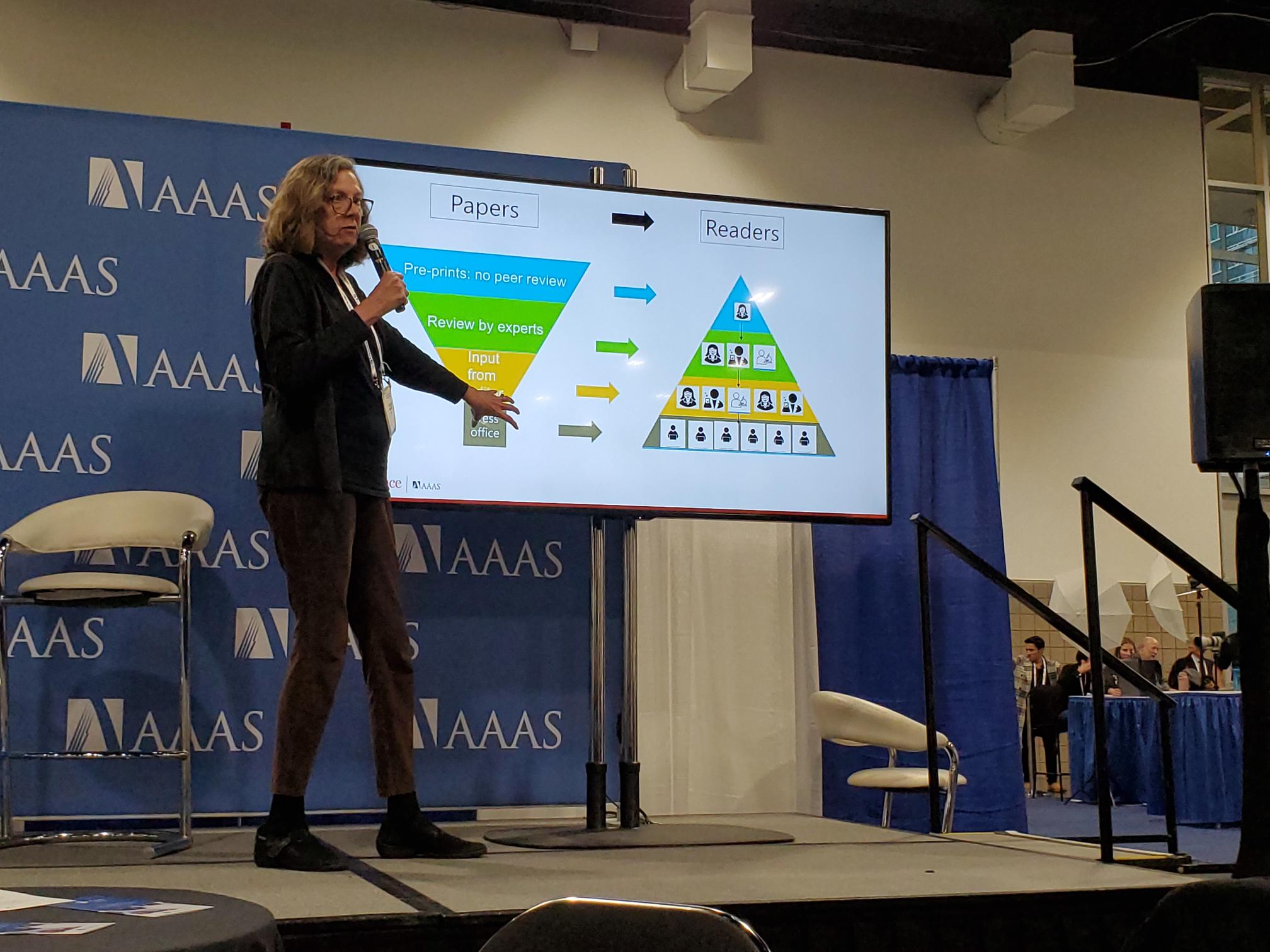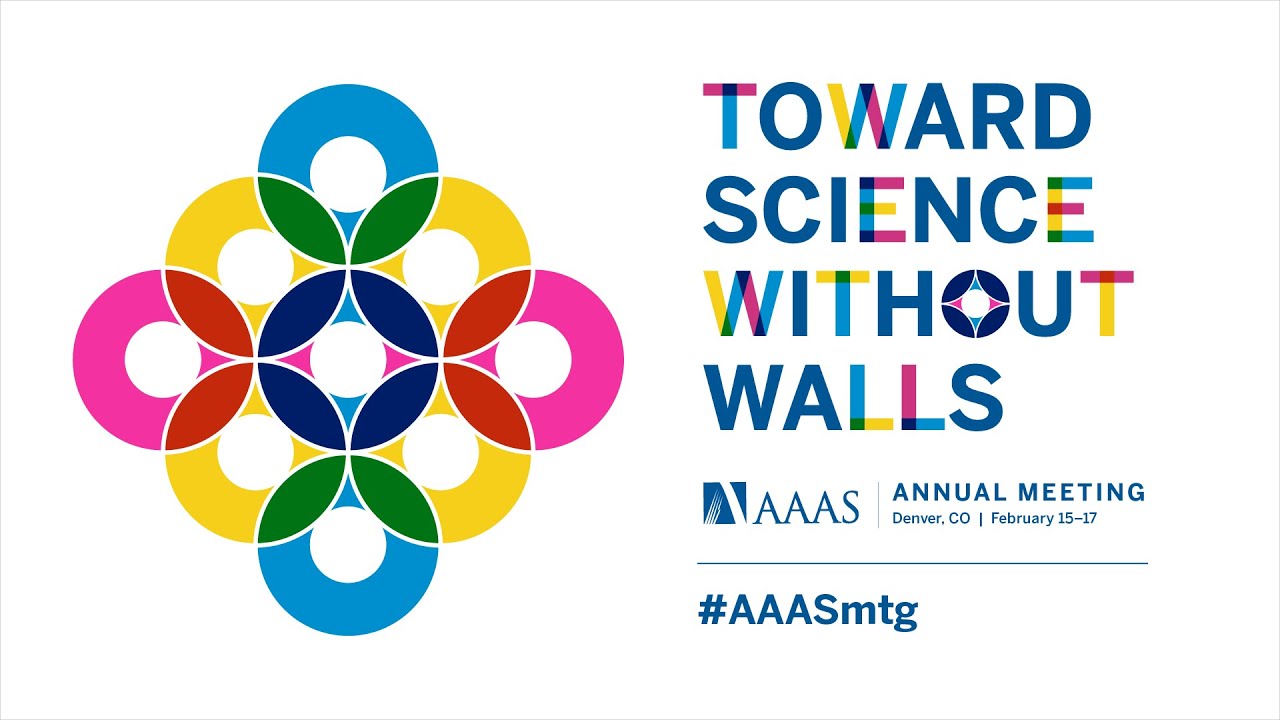After moving online during the COVID-19 pandemic1,2 and later being attempted as a hybrid event,3 the annual meeting of the American Association for the Advancement of Science (AAAS) returned to fully in-person for 2024. Held February 15–17 in Denver, CO, the 2024 meeting bore the theme “Toward Science without Walls.” The current report shares some of the meeting content of potential interest to science editors and those in related realms.
Behind the Scenes at the Science Journals
Valda Vinson, executive editor for the Science journals, discussed the selection and publication processes at Science and other journals published by AAAS, summarized below (Figure)

Journals now inhabit an ecosystem that includes social media, preprints, and news. Editors consider how journals fit in; thinking about audiences is key. Research becomes accessible to progressively broader audiences as its communication progresses through various stages: preprint, journal submission, peer review, editing, and dissemination to and through the press. During this process, editors select, enrich, and share.
Science receives about 11,000 papers per year, of which it publishes about 750. A paper in Science generally must do 1 or more of the following: significantly advance scientific understanding, present important new data, have societal impact, or be of broad interest. The papers should be important to share with a wide audience and must be of high technical quality. Items that help make a paper suitable include convincing data, appropriate controls, and careful presentation. Items that can hurt include excessive speculation, which can undermine work, and insufficient support for the most exciting conclusions.
What happens when a paper arrives at Science? First, members of the board of reviewing editors and journal staff review it. This process takes 1–2 weeks. About 75% of papers are rejected at that point, often because the research seems more suited for a specialized journal. The remaining papers proceed to in-depth review by at least 2 reviewers. The reviewers should be experts in the research methods and experimental system used and should not be direct competitors of the authors; diversity in reviewers is sought. Once the reviews arrive, each reviewer receives anonymous copies of the other reviews; this cross-review seems to have decreased the number of nasty reviews. Reviewers can respond to other reviews if they wish; they have 48 hours in which they can do so.
Science strives to promote reproducibility of research it publishes. Editors’ involvement in doing so includes using a checklist of criteria in this regard and doing technical editing. Papers also are checked for image manipulation; the errors found tend to be careless ones, such as problems in labeling, that may be avoided by sound data management. All data must be available at publication time, and authors must ensure that all reasonable requests for materials will be fulfilled.
“We edit your paper to make it more understandable to a broader readership,” Vinson said. Other individuals, such as those in the press office, help make the content accessible beyond the scientific community. Publication, Vinson emphasized, is “an important and integral part of doing the science” and is vital to AAAS’s mission of furthering science-informed decision-making.
Beyond Academic Walls: Providing and Pursuing Successful Internships
Barbara Gastel, of Texas A&M University, presented a workshop intended to aid current and prospective internship hosts and interns. The content can apply to various internships, including those in communicating science. Main points are summarized below.
Benefits for interns can include chances to reinforce and extend knowledge and skills, explore career options, network, obtain professional references, and build portfolios. For hosts, benefits can include obtaining help with tasks, gaining exposure to new ideas and resources, and evaluating prospective employees or freelancers, as well as contributing to the profession. Also, internships can increase visibility of host institutions and interns’ institutions, and communications by interns can inform fellow students and help faculty stay current.
Prospective interns can seek internships through postings, databases, events such as internship fairs, and networking. In addition, ad hoc internships sometimes are established. Similarly, prospective hosts can seek interns through postings, internship fairs and such, and networking, including with educational programs that may provide interns. Before searching, interns and hosts should consider their respective goals, qualifications, assets, and constraints.
To begin well, the intern should research the internship site, expect less structure and more ambiguity than in classwork, be flexible, be willing to ask questions, and observe the site’s culture. The host should make (or delegate) logistical arrangements, provide a tour (literally or figuratively), find out the intern’s priorities, clarify expectations, and introduce the intern to others.
During the internship, interns should show initiative, seek and apply feedback, learn from various people, keep a journal, and keep copies of work. Hosts should meet regularly with the intern; remember to provide feedback, including encouragement; try to gear some work to the intern’s particular interests; involve the intern in a range of activities; provide increasing responsibility; and, if feasible, include some “goodies” (such as participation in site social events).
At the end of the internship and beyond: Interns should reflect on and share their experience; thank the host and others; and, if appropriate, stay in touch. Hosts should bring the internship to closure; if warranted, offer to serve as a reference; perhaps stay in touch; and reflect on the experience and proceed accordingly.
Tips for remote internships include the following: ENSURE sufficient structure, including frequent regularly scheduled meetings of intern and host; involve other team members; use means of continual contact, such as messaging apps; model best practices for remote work; and if feasible, include an in-person component, such as a visit to the internship site.
Nonpartisan Science Communication in a Polarized World
Shenandoah Sowash and Mark Kuykendall, both of the U.S. Government Accountability Office, presented an interactive workshop on communicating with general audiences about polarizing topics.
In opening, Sowash elicited an example of a conversation that was with a nonscientist and turned partisan. She noted that touting one’s scientific expertise tends not to be persuasive in such situations.
Communication, the speakers noted, is rooted in 3 items: the goal, the audience, and the message. Merely raising awareness, they said, is not a strategic goal. They recommended asking oneself, “What do I want my audience to do, and how can I get them there?” They said the goal should be “measurable, specific, and reasonable.”
The speakers emphasized identifying the specific audience to reach. “The whole world is not your audience,” they said, adding that “audiences don’t need to be big to be powerful.” They recommended targeting decision makers. They also discussed creating a persona (a composite of members of the intended audience) to envision when planning communications.
The speakers recommended considering from the audience’s standpoint why it should care. They encapsulated this perspective as WIIFM (“What’s In It For Me?”). For identifying WIIFMs, they recommended considering the audience’s unique characteristics, its goals and aspirations, and its needs and challenges.
The goals and audience should then be considered in determining the message’s content and means of delivery. “You will not win people over with facts alone,” the speakers stressed.
The workshop proceeded to an exercise where each attendee was to designate an audience in their field, identify 3 WIIFMs of the audience, and indicate a desired action for audience members to take. These items were then discussed in small groups. The workshop ended with a full-group discussion.
Communicating Community Risk and the Critical Role of Statistical Science
Katherine B Ensor, statistics professor at Rice University, discussed initiatives to communicate statistical findings to local governments to promote public wellbeing. She focused on work she has done in Houston, TX.
Elevated atmospheric ozone levels substantially increase the likelihood of asthma attacks. Ensor described an effort, now underway for about a decade, to alert those in Houston when such atmospheric conditions are expected. This effort includes sending “asthma aware day messages” to relevant groups and individuals in the community.
Ensor also discussed monitoring the amount of the SARS-CoV-2 in Houston wastewater to help track the amount of COVID-19 in the community. City officials receive a “carefully curated” weekly email message in this regard, plus requested types of visuals. In addition, a dashboard on the topic is publicly available.
Using the asthma and COVID efforts as examples, Ensor noted the “importance of permanence” in such researcher-government partnerships to “bring actionable science to the community.” She also mentioned that the American Statistical Association is striving to promote public literacy in data science.
In closing, Ensor touched on measuring the impact of efforts such as hers. The measures, she stated, could include the ease with which the recipients of information can make scientifically informed decisions. They also, she said, could include community knowledge, actions taken, and outcomes.
On Giving Inclusive Presentations
Before the AAAS meeting, the organizers sent speakers a handout, based in part on material from the American Anthropological Association, on giving presentations that attendees with visual, auditory, or other limitations can readily follow. Some highlights applicable to conferences such as the Council of Science Editors annual meeting are the following.
In introducing a session, the moderator should state the title, date, and time of the session and say whether an American Sign Language (ASL) interpreter is present. Speakers introducing themselves should state their names, the titles of their presentations, and whether copies of their presentation and any supplementary information are available. It also was recommended that moderators briefly describe the room and that speakers state their preferred pronouns and describe their appearance.
For PowerPoint presentations: Use a solid background for slides, and provide high contrast between text and background (for example, black text on a light background, or white text on a dark background). Choose a sans serif typeface (such as Arial, Calibri, Helvetica, or Verdana). Ensure that all type is at least 18 points. Limit each bullet point to 1 line, and do not exceed 5 bullet points per slide. Describe visual representations (such as images, graphs, and maps). Run the “Check Accessibility” tool in PowerPoint.
When people ask questions, have them identify themselves by name. Likewise, have those answering questions identify themselves. Repeat each question into the microphone before answering it.
The handout also had sections on what to do if an ASL interpreter is present, what to do when presenting a video, and how to create digital access copies. Such copies can help people follow a presentation if they have visual or auditory disabilities or tend to lose focus.
And More
Also at the AAAS annual meeting, Monica Bertagnolli, who had recently become director of the U.S. National Institutes of Health, gave a talk titled “Fostering Learning-Based Linkages between Lab, Clinic, and Community.” In the question-and-answer period, she stated that “communication is one of our biggest objectives” and especially called for promoting open data sharing. She said she would like publications to have a new designation that says, “This publication resulted from a data-sharing environment.”
The 2025 AAAS annual meeting, themed “Science Shaping Tomorrow,” will be held February 13–15 in Boston, MA. Information is available at https://meetings.aaas.org.
References and Links
- Sumners CB, Agan J, Espinoza M, Han D, Gastel B. From classic to COVID-related: some communication highlights of the 2021 AAAS meeting. Sci Ed. 2021;44:43–45. https://doi.org/10.36591/SE-D-4402-43.
- Sumners CB, Barnes K, Hohlt A, Semro M, Han D, Chartier A, Gastel B. Empowering with evidence: some communication highlights of the 2022 AAAS meeting. Sci Ed. 2022;45:51–53. https://doi.org/10.36591/SE-D-4502-51.
- Gastel B. The 2023 AAAS annual meeting: some communication-related highlights—and challenges. Sci Ed. 2023;46:54–56. https://doi.org/10.36591/SE-D-4602-12.
Barbara Gastel (https://orcid.org/0000-0003-0804-2953) is a professor at Texas A&M University, where she directs the graduate program in science and technology journalism.
Opinions expressed are those of the authors and do not necessarily reflect the opinions or policies of the Council of Science Editors or the Editorial Board of Science Editor.

